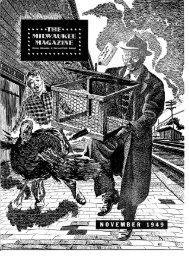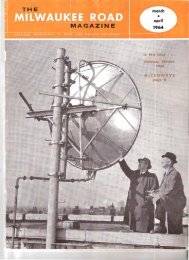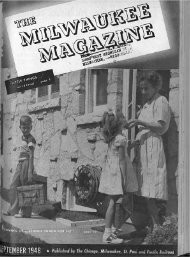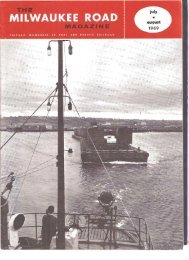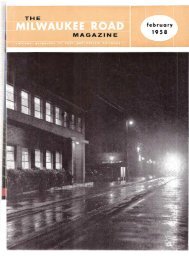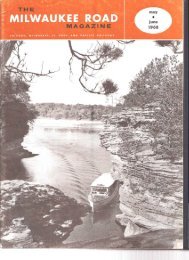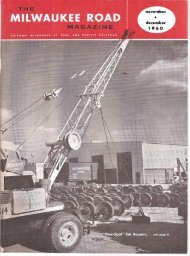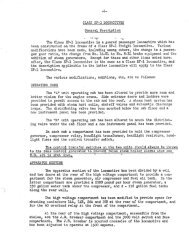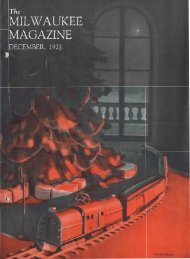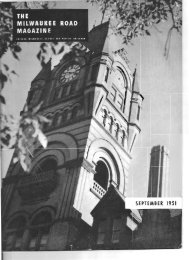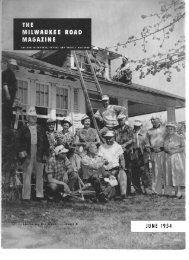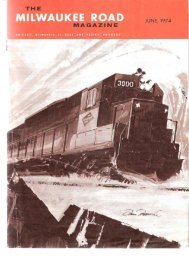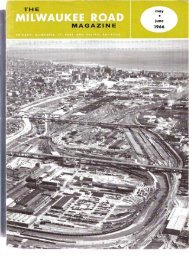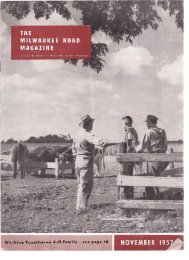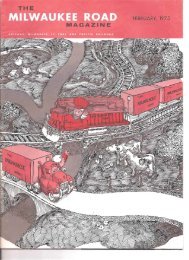JANUARY 1956 - Milwaukee Road Archive
JANUARY 1956 - Milwaukee Road Archive
JANUARY 1956 - Milwaukee Road Archive
You also want an ePaper? Increase the reach of your titles
YUMPU automatically turns print PDFs into web optimized ePapers that Google loves.
<strong>Milwaukee</strong> Makes Ready for the 5- 3<br />
As A TRIBUTE to the role played by the<br />
steam locomotive in developing <strong>Milwaukee</strong>,<br />
Wis. into one of the country's<br />
foremost industrial and metropolitan<br />
centers, that city on Jan. 2 launched a<br />
drive to raise funds for the permanent<br />
display of one of the fast-vanishing coal<br />
burners. The goal is $25,000, to be used<br />
to install the locomotive, an S-3 offered<br />
for the purpose by The <strong>Milwaukee</strong> <strong>Road</strong>,<br />
in a scenic setting in one of the public<br />
parks.<br />
Since the exhibit would be of educa.<br />
tional value to today's youth and future<br />
generations, school children have also<br />
been given an opportunity to participate.<br />
A "Name the Engine" contest which<br />
closes on Feb. 2 offers prizes to children<br />
from kindergarten through the eighth<br />
grade for naming the Iron Horse.<br />
The project was touched off by a letter<br />
which Mayor Frank P. Zeidler received<br />
from an eight-year-old girl.<br />
Representing her second grade schoolmates,<br />
she expressed their enthusiasm<br />
for the project and the opinion that their<br />
interest was shared by most <strong>Milwaukee</strong><br />
children. On the principle that the children<br />
of tomorrow should have an opportunity<br />
to know the place of the steam<br />
engine in the transportation era of the<br />
past, business, industrial and profession.<br />
al men have organized to support the<br />
8<br />
No. 265, an 5-3 which<br />
has been out of service<br />
since The <strong>Milwaukee</strong><br />
<strong>Road</strong> was dieselized in<br />
1955, is spruced up for<br />
its new job. From<br />
left: Machinist C. L.<br />
Christman, Machinist F.<br />
A. Scheidt (top), Helper<br />
H. Nick and Fore·<br />
man V. J. Janschutz.<br />
"Old Smokey" has been<br />
suggested as a name for<br />
the rail giant, which<br />
was the last word in<br />
steam power when it<br />
was built in 1944. Pic·<br />
ture taken at the Mil·<br />
waukee Shops.<br />
plan as a civic measure.<br />
The <strong>Milwaukee</strong> <strong>Road</strong> has received a<br />
number of requests from cities on the<br />
line for locomotives to be used as park<br />
exhibits, but for a number of reasons<br />
has refrained from g ran tin g them.<br />
Among them is the problem of arranging<br />
for maintenance once the exhibit is<br />
installed.<br />
An exception is being made in this<br />
instance in recognition of the city's position<br />
as the b i r t h P I a c e-"home and<br />
mother"-of The <strong>Milwaukee</strong> <strong>Road</strong>.<br />
The locomotive being offered for display<br />
represents the last word in steam up<br />
to the time of its replacement by the<br />
diesel. It weighs 412 tons, is 110 feet<br />
long, and cost $255,000 when it was<br />
built by the American Locomotive Company<br />
in 1944. In the 4,000 horsepower<br />
class, it can do more than 100 miles per<br />
hour, and was in constant freight and<br />
passenger service until 1955. At the<br />
<strong>Milwaukee</strong> Shops where it is being<br />
cleaned and polished, its salvage value<br />
was estimated at approximately $10,000.<br />
The money currently being raised by<br />
popular subscription will transport the<br />
locomotive to the display site and guarantee<br />
maintenance during its years as a<br />
park exhibit. The Iron Horse committee<br />
has not definitely determined where it<br />
will be placed, but a decision is expected<br />
shortly, as the weight of the locomotive<br />
makes it necessary to move it in February<br />
while the ground is still frozen.<br />
Moving plans call for towing it to street<br />
car rails and running it on its own power<br />
close to the site selected. Tentatively<br />
this choice is Washington Park.<br />
Everyone in the <strong>Milwaukee</strong> area is invited<br />
to contribute to the fund, and it is<br />
hoped that there will be enough contributions<br />
of $1 or more to do the job. The<br />
prizes for naming the locomotive are a<br />
$25 Savings Bond for first, a second<br />
prize of a $10 savings certificate, and a<br />
model train for third prize. Plans for<br />
the exhibit include the installation of<br />
two suitably inscribed bronze plaques,<br />
one with the names of The <strong>Milwaukee</strong><br />
<strong>Road</strong>, special committee members and<br />
park commissioners, and the other with<br />
a short history and description of the<br />
locomotive.<br />
L. D. Phelan Retires as<br />
General Adjuster<br />
AN UN US U AL<br />
career of railroad<br />
claim w 0 r k and<br />
public s e r vic e<br />
reached an important<br />
milestone<br />
at the end of December<br />
with the<br />
retirement of L.<br />
D. Phelan, general<br />
adjuster. He<br />
L. D. Phelan had been in rail.<br />
roading 47 years,<br />
and with the <strong>Milwaukee</strong> more than 34.<br />
Mr. Phelan recalls that his career be.<br />
gan, somewhat unofficially, at the age of<br />
12 when he took a job as messenger for<br />
the Missouri.Kansas-Texas Lines in his<br />
home town of Sedalia, Mo., at $13 a<br />
month. His interest in railroading came<br />
naturally, as both his father and grandfather<br />
had had long years of service with<br />
the M-K-T.. Other interests and occupations-principally<br />
his work as a trumpet<br />
player in local orchestras-intervened,<br />
however, before his finally decided on<br />
railroading as a career.<br />
In 1908 he took his first regular railroad<br />
job-with the M-K.T in Sedaliaand<br />
later served with various railroads<br />
in the Southwest before coming to The<br />
The <strong>Milwaukee</strong> <strong>Road</strong> Magazine



